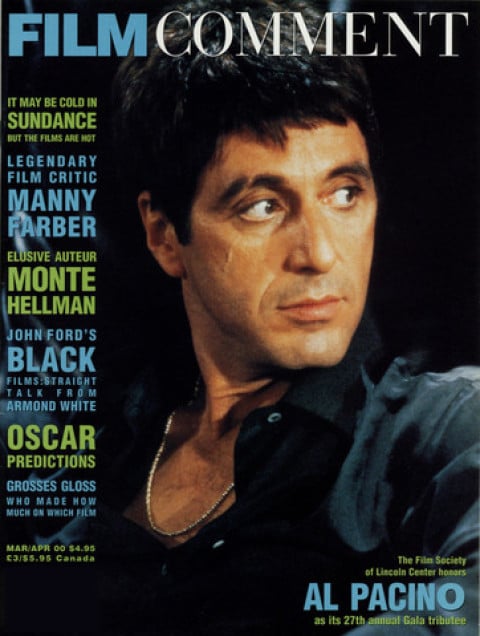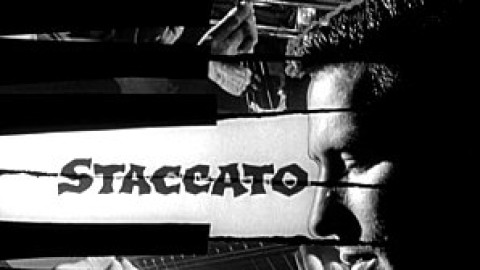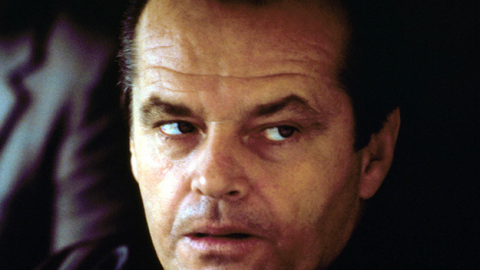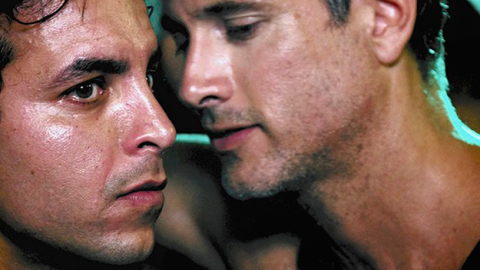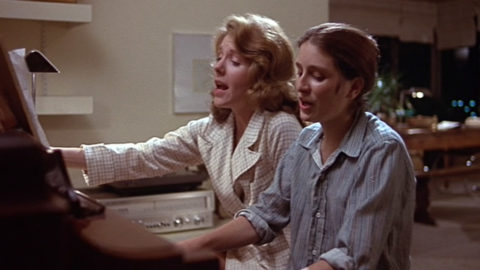
Looking for Richard
In Looking for Richard, his 1996 documentary about Shakespeare, Al Pacino’s been out and about, buttonholing scholars, colleagues, regular people on the streets of New York, interrogating everyone and his brother regarding the significance of the Bard and Richard III. Now the director/actor is in costume—all black with slashes of silver—set to accost poor grief-stricken Anne (Winona Ryder) as she attends the corpse of her husband, murdered in accordance with Richard’s machinations. The great dissembler turns and leans into the camera, like some grinning salesman—say, Ricky Roma in Glengarry Glen Ross—eager to get out on the floor and work his scam: “Was ever woman in this vein wooed? Was ever woman in this vein won? … I’ll have her!” he chortles lewdly, projecting the kind of sharklike appetite Scarface shows at first glimpse of his boss’s high-priced whore (Michelle Pfeiffer).
But it’s not lust for womanflesh or even the English crown that turns Richard—Al Pacino—on. It’s the heady challenge of entering inert, undefined space and making yourself the fulcrum of emotion, event, action. Of embracing a dramatic persona so intimately it possesses and moves you. Of sharing that addictive consummation with appreciative witnesses. Waifish Anne—Winona—is no match for the creature who courts her with such suave, insinuating grace. Indeed, drawn by the seductive power of Pacino’s physicality and voice, we too momentarily lose sight of the con. But, postcoitum, Pacino brings Shakespeare’s Heartless, guffawing ham (close kin to Satan in The Devil’s Advocate and even Dick Tracy’s Big Boy Caprice, Richard Crookback as comic-strip Corleone) back into camera closeup to reprise, in lascivious triumph, his “Was ever woman in this vein wooed?” speech. Having shown us the bare bones of theater and deliberately let us in on the tricks of the trade, he’s nonetheless conjured magic. High on the power of performance, Richard demands—and earns—our complicity in his dangerous fun.
Such is the high-wire act Al Pacino has been pursuing on stage and screen for three decades. The metaphor shows up again and again in the few in-depth interviews this very private movie star has given over the years. Comparing critical panning of his Richard III to the tragedy of a trapeze artist’s fall, Pacino quoted the Flying Wallendas’ credo: “Life’s on the wire, the rest is just waiting.” His epiphany when he first set foot on stage—”I felt that I had the license to speak and that I was Everyman and that I was timeless and that I was universal … I love to talk and say and feel all those things, make things happen”—is shot through with the kind of wonderfully arrogant euphoria one usually associates with a very young man. But on the evidence of his career, Pacino’s passion, his addiction to the rush of crawling inside gangsters, cops, heroes, scum, Satan, et al., has not abated one jot.

Serpico
For a long time, this onetime student of Method acting (in Lee Strasberg’s Actors Studio) was notorious for going so deeply into character that there were fears he would not return. (Someone once swore he saw Pacino’s character leave the actor’s body.) Sidney Lumet, who directed Pacino in Serpico and Dog Day Afternoon, recalls that “if the day’s work demanded a lunatic, he was a lunatic all day long.” Even Strasberg warned his protégé, “Darling, you have to let go sometime.” Lots of writers and interviewers have gone “looking for Al,” the enigma behind (within?) the obsessive actor who won an Obie and a Tony and five Oscar nominations during his first seven years in the business.
The enigma remains obstinately in hiding, convinced that personal revelations get between audiences and whatever fiction he performs, sure that in an age of relentless promotion the public might enjoy his interviews so much “that they would no longer want me to act, just do interviews.” He’s not seen much, either, on the celebrity circuit; Pacino’s canny about the way fame can turn an actor inauthentic, flaccid in the kind of interactions that tune imagination, identity, the performing instrument: “I realized people were receptive to me. And I hadn’t earned it. I had done nothing to earn their laughs, or their interest or anything. And it felt kind of cool to just sit there and not have to earn it. And I think that’s a trap….”
So let me say right from the get-go, I don’t have the least idea who Al Pacino really is. (Or “Al De Niro,” as he has occasionally dubbed himself, in joking acknowledgment of his frequent confusion with that other New York Godfather.) Somehow persuaded into a Barbara Walter interview, the man who’d choose Dostoevsky or Chekhov as his biographer later congratulated himself on having revealed nothing, on taking cover in a charming tango with the dissector of celebrity psyches. What I know of Al Pacino are his dances on the high wire. Watching this obsessive performer at work on the screen, you can see the way his characters borrow from each other across the years, so that a physical nuance here signifies differently in the crucible of another lifestyle, an emotional dynamic there is deformed by unfamiliar pressures. All of Pacino’s personae have a little touch of Richard III; richly related, the best of his men are singular creations, lonely, alienated, sweet, sad, violent, innocent, corrupt dissemblers.

Scarecrow
In first films such as Panic in Needle Park (71) and Scarecrow (73), Pacino is all nervous energy, puppyish and still a little pudge-faced. In Panic, playing a hapless junkie, he’s stunted, stunned by the stuff he puts in his veins and by each stage of decay in his moral/emotional life. Here’s a small soul that tragically adapts to every devolution; his button-dull eyes slide away from whatever object or person he’s trying to connect with, as though he can’t or won’t trust any existential anchor. This early, Pacino’s perfected the macho street strut: shifting one shoulder around and forward, so that arm propels the torso into the familiar sideways, up-and-down rhythms of the gangsta bounce. Ratted out by his addict girlfriend (Kitty Winn), he emerges from jail and ignores her pathetic presence, walking straight toward the camera as she trails behind. Eventually, he gives in—in eloquent New York nasal-ese—to love on a yet lower rung: “Well?”
A buddy-buddy road movie in the vein of Rain Man or Of Mice and Men, Scarecrow‘s too cute by half. But it offers a rare opportunity to see a smiling Pacino at comic, even physical, play. He seduces trigger-tempered Max (Gene Hackman) into friendship by acting out like a guileless, overgrown kid during a long, mostly silent sequence along a Midwestern backroad. In a very funny scene in a junkyard, while Hackman and the ineffable Ann Wedgeworth concentrate on sweet-talking each other into bed, Pacino’s diminutive figure, insanely focused, lugs huge doors and other unlikely burdens past and between them, causing great crashing sounds offscreen. It’s in the Buster Keaton tradition, the kind of comedy Pacino has said he’d like to pursue.
Cornered by a prison rapist (the always-loathsome Richard Lynch), Pacino’s sort-of-holy fool splays himself up against a wall, then, in Hammer-movie style, puts a hand up to halt his attacker, intoning in a fake British accent: “Back, monster, back.” In Scarecrow‘s lost Lion, you can see signs of Dog Day Afternoon‘s doomed, good-hearted Sonny (“I’m dyin’ here”), and even of Lefty Ruggiero, Donnie Brasco‘s fatalistic Mafia foot soldier: little guys too dumb to live.
Lion and Sonny stumble onto the stage, desperate, accidental performers with limited range. When their illusions are punctured by more ruthless players, dramatic air visibly leaks out of them—leaving Lion catatonic and Sonny sprawled over the hood of a police car, facing the camera, his realization that he’s been transformed into an instant nobody ours to share, up close and personal. But the role of Michael Corleone in the Godfather trilogy offered Pacino a remarkable opportunity to play out a mythic arc, rising from bit player to spotlighted actor/director—frozen on a Dantean stage with an ever-diminishing cast—then sinking into the final dying fall at the end of Godfather III (90) when his small, distant figure, seated alone in a sun-filled frame, dreaming of long-ago dances, simply tips over to earth. Epitaph: “My kingdom for a horse.”

The Godfather
Cast by Francis Ford Coppola against all advice, nearly fired for under-emoting, Pacino enters The Godfather (72) as an All-American boy, his hair combed high over his forehead, fresh-faced, a little bland, lacking in ethnic color or style. Dancing at his sister’s wedding, he’s a disengaged onlooker, regaling his WASP girlfriend (Diane Keaton) with Grimm fairy tales about his exotic family. In his father’s dark den, hot with the dynamics of ritual sacrifice and god-given benisons, Michael never takes fire; Coppola’s camera passes him by, drawn by the irresistible, potent stillness of Vito Corleone (Marlon Brando) and the kinetic energy of brother Sonny (James Caan).
But from the moment Michael enters the hospital where the wounded don is about to be finished off, the understudy begins to claim center stage, to direct his supporting cast and organize the trajectories of action. “I am with you now,” Pacino whispers passionately to Brando, his prostrate father. It’s a declaration of a son’s new standing: in film frame, acting fraternity, fiction. (His jaw and cheek soon crushed by a crooked cop’s terrible blow, Pacino speaks in something like Brando’s distinctive Vito Corleone voice for much of the rest of the film.)
After the near-hit, amid chaos and hysteria, Michael sits in his father’s room, legs crossed, emerging as a still, sure point of authority. His presence composes the shot. How swiftly, seamlessly, Pacino morphs his cleancut Marine into Mafia assassin, man into gun, sights locked on to the main chance for stardom and success. You can see the adrenalin high taking hold as Michael slips into acting the role of killer and don—and finds it good. Watch Pacino as he aims himself to gun down Sollozzo (Al Lettieri) and McCluskey (Sterling Hayden): eyes darting, chin tightening spasmodically, his face comes alive, visibly filling up with murder. By the end of The Godfather, after shattering blows to body and Heart, the dancing boy has become a dead man walking. Saturnine, Machiavellian, masked, given to eruptions of molten rage, he owns the stage utterly.
Consider that Pacino’s elegantly performed anatomy of a monster was only his second starring film. Just three years after Panic in Needle Park and the year before his wired schlemiel in Dog Day Afternoon (75), in The Godfather, Part II (74) he’s gaunted up that Goya-esque visage, infected his black, chasm-deep eyes with corruption. The high cheekbones are beginning to emerge in scimitar curves that look as though they’ve been scooped out by a sculptor’s cruel chisel. He’s beginning to master the characteristic Pacino rhythm of tightly coiled stillness punctuated by emotional eruptions as killing as hammer blows. Watch Pacino propose to Diane Keaton in The Godfather, as passionate as a practiced snake mesmerizing food: “I need you.” Witness the implosive agony in his face as he stands behind his drunken brother Fredo in Godfather II, who’s just inadvertently confessed himself Michael’s Judas. The music he finds in words has him now; Pacino rides the instrument of his voice—on a scale rising from whisper to rant—trying for something like the way Dylan Thomas voluptuates in sounding out his cosmic lines. (Showing off his exhibitionist style in Heat, he shamelessly invites applause from a browbeaten snitch: “Ain’t I ferocious?”) By the end of Godfather II, Pacino has constructed a truly Mabusian soul, operating spiderlike from some very cold, silent outpost.
Serpico (73) traces another kind of evolutionary journey, from cleancut young police recruit to hirsute whistleblowing hippie. But Pacino’s Serpico is no simple saint; he’s played with some of the complex eccentricity Russell Crowe finds in The Insider‘s Jeffrey Wigand. He embraces the Platonic purity of an incorruptible persona with the same perverse ardor Michael Corleone displays as he assumes the heady role of star sinner.

Cruising
Another of Pacino’s undercover men, the cop in Cruising (80), becomes a mole in New York’s gay S & M scene. At the start, this good-looking youngster conveys a lightness of character, a virginal quality in flesh and psyche. Accompanied by the creak of leather, the hard jingle of metal, Pacino’s Candide travels deeper into his own Heart of darkness; along the way, his face seems to ripen, his body grows heavier, and something goes very dead in his eyes when he gazes at his white-bread girlfriend (Kathleen Quinlan) after their unfictionalized lovemaking. Sexualized and seduced by verboten role-playing, Pacino’s cop explodes into orgiastic dance with a roomful of men in an underground dive, his lips wet with excitement, with pleasure in his own body, with the taste of violence generated by macho dressing-up and acting-out.
You might say that clothes make the men in Pacino’s pantheon of idiosyncratic outlaws: Tony Montana (Scarface, 83), Carlito Brigante (Carlito’s Way, 93), and Lefty Ruggiero (Donnie Brasco, 97). From the start, Montana can hardly be bothered to mount a credible human disguise, to convince U.S. immigration officials that he is something more than an undesirable alien. His flat eyes cocked and his lips held slack with the kind of cool contempt that presages indiscriminate feeding, this “peasant” (elsewhere: “fucking little monkey”) is nothing more than amoral appetite, a bad actor in a cheap suit for whom performance never rises above brute action. Pacino fashions his voice out of labials and sibilants so that Montana’s words seem to be tongued lubriciously around the inside of his mouth, mere appetizers to the main course: the assault, the sex, the money, the cocaine.
After the force of his hunger propels him to the top of the world, Montana runs out of steam and simply squats there, a drunken, murderous pig. The sheer ruthless energy of his acquisitiveness burned with a certain bestial beauty; when that energy dead-ends in unlimited “eating, drinking, fucking, sucking, snorting,” no epiphany invests Tony’s fall with tragic resonance. Pacino makes us see that sated appetite bloats him into dramatic immobility. Lacking the means to evolve, to imagine himself into a new suit of clothes, Pacino’s Tony Montana loses definition, any raison-d’être, and is galvanized only by death throes. In the first-rate Donnie Brasco, Pacino creates Scarface‘s opposite: short on style, grace, or self-awareness, Lefty Ruggiero can’t even aspire to smalltime sharkdom. In flat-brimmed porkpie hat and tacky plaid carcoat, this Willy Loman on the Mafia totem pole telegraphs his role as eternal extra. Everything about him tends downward, suffers from gravity. But deft Pacino weaves nobility out of this sad sack: after feeling out whether his protégé (Johnny Depp) might be an undercover Judas, Lefty screws up a funny-face, then lightly slaps and lays a fond caress on his adopted son’s cheek. Subtly communicated, it’s a loser’s acknowledgment of love, betrayal, and coming crucifixion. At film’s end, Pacino performs Lefty’s last rites with unimpeachable dignity, revealing the shape of some kind of samurai within his tired form.

Donnie Brasco
In contrast, Carlito Brigante, one of Pacino’s finest and most beautiful creations, is all elegant definition, a Puerto Rican samurai who marries content with style, action with self-awareness. Returning to his old neighborhood after five years in prison, this retired druglord saunters through crowded streets like an aging gunfighter. A Mifune among urban dregs—bearded and sporting dark glasses, black suit, full-length leather coat, cowboy boots—he’s an anachronism, giving off the romantic aroma of angst. Corraled into keeping a young nephew company during a poolroom payoff, Brigante is instantly attuned to the fatal dynamics of the mise-en-scène. It’s exhilarating—like watching Picasso paint on glass—to watch the expertise and grace with which Pacino begins to make this fraught stage his own, anticipating the vectors of the double-cross, the roles the killers around him will play.
Like Michael in Godfather III, Brigante wants out, dreams of finding a path to paradise. But Carlito stands outside himself sufficiently to comment (voiceover) with fatalistic irony on his efforts to go legit: “Here’s me in the club, playing Humphrey Bogart.” Having insulted a smalltime hood (John Leguizamo) and then allowed the outraged punk to live, Brigante turns critic, analyzing the drama that keeps pulling him back in: “Dumb move, man … I know what happens now … Benny’s got to go down … the street is watching … I can’t do that shit no more.”
When someone chivvies Brigante that Leguizamo’s arrogant urban cowboy might be the old hand twenty years ago, he gravels out, “Never me … never me,” and the repetition becomes a kind of poetic invocation of past and present Pacino characters and wannabes. As Carlito’s life bleeds away, forfeit to his purist reading of “who I am,” Pacino applies that richly abraded voice to an outlaw ballad: “Lay down, lay down … the Last of the Mohicans … last call for drinks … bar closing down … where we goin’ for breakfast? … rough night … tired, very tired.”
Those melancholy litanies recall earlier fathers and sons in the Pacino canon: in Godfather III, post-stroke, Michael Corleone is lifted into bed by the young mafiosi who will replace him (Andy Garcia). Pacino makes himself small, fragile, as Garcia, swollen with health and virility, tenderly moves his flaccid limbs. Throughout, the two men unobtrusively touch each other; it’s in those minimalist caresses that the exchange of love and power is achieved. (One regrets that Garcia has never fulfilled his promise as an actor; here, he is enlarged by his proximity to Pacino.) In the first Godfather, Pacino, turned partly away from the camera, shared a garden bench with the worn but still potent Brando, who faces forward as he teaches his son how to play the don—though “I never wanted this life for you.” The younger actor has few lines; his primary function is to listen, yet the tyro somehow manages to claim space with uninsistent equality.

The Insider
Pacino’s honed that facility for active listening or apprehension. He’s capable of registering what he sees and hears with fierce acuity. Working with equals or heirs, this is an actor whose interest lies in the pitch-and-catch of performance, not wiping every presence but his own from the frame. From the wonderful two-part harmony he and the estimable Charles Durning orchestrate in Dog Day Afternoon; to the quiet, cross-cut exchange of existential ethics between Pacino’s cop and De Niro’s robber in Heat; to the easy rapport between a mobbed-up nowhere man (Pacino) and Johnny Depp’s Donnie Brasco, a pretender losing himself in his own fiction; to the subtle rhythms of conversational foreplay—in a car parked in the rain—between Pacino and Russell Crowe in The Insider, you appreciate how this actor somehow manages to share without giving ground.
In Carlito’s Way, Brigante loves a young dancer (Penelope Miller), seeing in her dedication something akin to his professional code; when he discovers her working in a strip club, Pacino squares his body as though he’s been struck. His whole face effloresces in surprise, a kind of embarrassed shock that shades into shamed delight. He somehow pulls to the surface an innocence rooted in layers-deep experience. In Donnie Brasco, Pacino’s over-the-hill Mafia schlub sits in the bow of a luxury cruiser and watches his sleek young protégé hobnob with the bigwigs, stealing Lefty Ruggiero’s last chance to be somebody. Weariness, disappointment, and pain weight the flesh of his face; but a kind of wondering appreciation of Donnie’s/Depp’s performance leaks through. (See Glengarry Glen Ross for a variation on the theme: the appreciative rapport and rapid-fire improvisation between old-timer Jack Lemmon and Pacino, playing hotshot comer.)
Juxtapose Lefty’s nuanced look with a telling projection that sharply defines the aesthetic discontinuities of Scent of a Woman (the 1992 performance for which Pacino won his long-overdue Oscar) as well as Pacino’s power to overwhelm unworthy material: Chris O’Donnell and Pacino are wrestling for a gun, and the life of suicidal, blinded Frank Slade. No Depp or Crowe, blond O’Donnell is nearly transparent in his sweet admiration for the dark, demonic presence in his arms. The film’s been fudging right along, trying to sell Slade as nasty but loveable curmudgeon. Pacino’s expression is so pure it exposes the lie of his character as written: the lined face opens like a crater in which life itself has exploded, scoring the flesh. His eyes are like tunnels down into unmitigated despair, a hell reserved for a bad man who has lived badly and is now condemned to live alone in the dark with nothing but bad memories. Beneath this skin is Corleone bone, Richard Crookback’s toxic marrow.

Scent of a Woman
When it comes to onscreen lovemaking, Pacino mostly eschews naked eroticism, preferring a sexual reticence remarkable among mainstream American film stars. For me, his worthiest consort has been Ellen Barkin in Sea of Love (89), the comeback movie he made after four years’ absence from the screen (following the disastrous period piece Revolution). Barkin’s quirky gorgeousness, her self-reliant sexuality, arouse Pacino to rare passion. At one point, the lanky Barkin and a somewhat shorter Pacino almost literally fling each other around her apartment on their way to heated consummation. In the claustrophobic confines of a tiny kitchen, Barkin confronts her cop with his hurtful duplicity and Pacino aims his blasted face and speaking eyes, assaulting her with naked existential loneliness: “I cannot lie down in my bed without you … lie down with me.” Hunger this well-deep has less to do with flesh than soul; Pacino brings something like this spiritual vastation to the table in almost every cinematic sexual encounter.
Looking back over Pacino’s filmography, one could wish there were more Coppolas and Lumets and fewer Hillers and Marshalls in the directorial mix. By his own admission, Pacino prefers to look away, focusing on his own job, when he twigs to directorial weakness. And you can on occasion see how strongly he’s given to following his own bent in a rudderless film. On the evidence of Heat (95) and The Insider (99), it’s clear that Michael Mann provides the kind of directorial control that has served Pacino superbly: “[It’s] his film, and you are in it…. You can let it go and just be whatever your guy is.”
Taut thriller and chronicle of a kind of love affair between unlikely heroes,The Insider really consists of a series of conversations between Pacino as Lowell Bergman, “60 Minutes” producer, and Russell Crowe’s tobacco company whistleblower. By phone, fax, in hotel, car, restaurant, outdoors—Crowe, baby-faced, white-haired, and pudgy, and Pacino, all dark, driven cragginess, show off their acting chops, measure each other’s worth and style, exchange roles. Pacino’s method for inspiring Crowe to moral action is to put himself in Jeffrey Wigand’s way, to be quietly there in such a way that he bodies forth Wigand’s own standards and beliefs. This brand of catharsis – “catching the conscience”—grows out of one of acting’s primal functions. Call Pacino salesman, shrink, devil, he’s a moral player in the theater of “60 Minutes.”
Mann makes the process through which truth is mined mysterious, even mythic as Pacino simply watches—umbilically attached to the motions of his double’s mind and character—as Crowe walks along the Mississippi Gulf, wrestling with the decision to go public with what he knows about big tobacco’s rigging of cigarettes as ultra-efficient “delivery systems” for nicotine. Deprived of an audience for the heroic role that’s cost him everything, Wigand sits despairingly in a hotel room, watching the wallpaper dissolve into home movie: his lost daughters gaze at him across a garden that mocks his outsider’s sterile state. On a distant beach, in blue-steeped twilight, Pacino faces the vastness of ocean and sky while trying to phone and save the suicidal Crowe. In some eerie fashion that doesn’t entirely yield to analysis, Mann, Pacino, and Crowe tap into the electric circuit between players and the power lines of performance. Our existential stages and screens are illuminated by the shock of recognition they generate.
At film’s end, when Bergman exits CBS, his corrupted theater of operations, his passage outdoors is italicized in iconographic slow motion. Trace that movement back to the door shutting in The Godfather‘s last shot, a final curtain closing on Michael Corleone’s apotheosis as lord of lies, framed forever in solitary confinement. Master of masked poise and naked kinesis, Al Pacino has surely made his bones as high-wire dancer, delivery system for truth.



